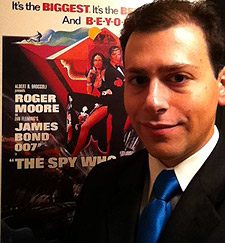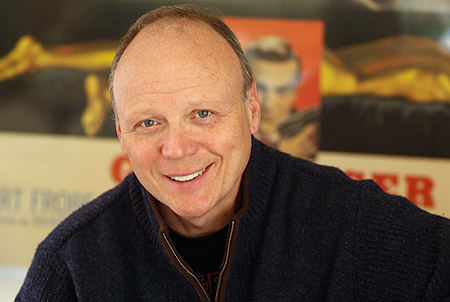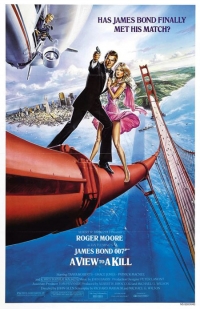“Unlike most of the Bond films, [A View to a Kill] lacks the sense of cleverness that is so instrumental to the success of 007. It is a film where everyone was working a bit too quickly, where the inherent tone of a Bond film was in short supply, the Bond film that feels the most like an expensive TV movie. It is the Bond film that should have gotten the Mystery Science Theater 3000 treatment.” — John Cork
The Digital Bits is pleased to present this retrospective commemorating the 30th anniversary of the release of A View to a Kill, the 14th (official) cinematic James Bond adventure and, most notably, the final to star Roger Moore as Agent 007. [Read on here...]
As with our previous 007 articles (available here and here and here), The Bits continues the series with this retrospective featuring a Q&A with an esteemed group of James Bond authorities who discuss the virtues and shortcomings of A View to a Kill and analyze whether or not the passage of time has been kind to the film. The interviews were conducted separately and have been edited into a “roundtable” conversation format.
Okay, let’s (alphabetically) meet the participants…
Robert A. Caplen is the author of Shaken & Stirred: The Feminism of James Bond (Xlibris, 2010). An attorney based in Washington, DC, he practices antitrust and commercial litigation and has published numerous law review articles in leading academic journals. Shaken & Stirred: The Feminism of James Bond (which was quoted in Sir Roger Moore’s memoir, Bond on Bond) is his first book. He is working on a follow-up book and can be reached via Facebook (www.Facebook.com/bondgirlbook) and Twitter (@bondgirlbook).

John Cork is the author (with Bruce Scivally) of James Bond: The Legacy (Abrams, 2002). He also wrote (with Maryam d’Abo) Bond Girls Are Forever: The Women of James Bond (Abrams, 2003) and (with Collin Stutz) James Bond Encyclopedia (DK, 2007). He is the president of Cloverland, a multi-media production company, producing documentaries and supplemental material for movies on DVD and Blu-ray, including material for Chariots of Fire, The Hustler, and many of the James Bond and Pink Panther titles. Cork also wrote the screenplay to The Long Walk Home (1990), starring Whoopi Goldberg and Sissy Spacek. He recently wrote and directed the feature documentary You Belong to Me: Sex, Race and Murder on the Suwannee River for producers Jude Hagin and Hillary Saltzman (daughter of original Bond producer, Harry Saltzman); the film is available on iTunes, Google Play and other streaming platforms.

Bill Desowitz is the author of James Bond Unmasked (Spies, 2012; www.jamesbondunmasked.com; and updated for Kindle which includes a chapter on Skyfall and exclusive interview with Sam Mendes). He is the owner of Immersed in Movies (www.billdesowitz.com), a contributor to Thompson on Hollywood at Indiewire and contributing editor of Animation Scoop at Indiewire. He has also contributed to the Los Angeles Times and USA Today.

Andrew McNess is the author of A Close Look at ‘A View to a Kill’ (Xlibris, 2011; and updated in 2015). Based in Melbourne, Australia, Andrew works for a not-for-profit organization that supports bereaved families. He has a doctorate in sociology and has published scholarly work in subject areas such as youth bereavement, peer support and health promotion. He greatly enjoys combining his writing interests with a lifelong interest in film, and continues to do so via a site of Bond-related commentary, A View on Bond: www.aviewonbond.com.

Lee Pfeiffer is the author (with Philip Lisa) of The Incredible World of 007: An Authorized Celebration of James Bond (Citadel, 1992) and The Films of Sean Connery (Citadel, 2001), and (with Dave Worrall) The Essential Bond: The Authorized Guide to the World of 007 (Boxtree, 1998/Harper Collins, 1999). He also wrote (with Michael Lewis) The Films of Harrison Ford (Citadel, 2002) and (with Dave Worrall) The Great Fox War Movies (20th Century Fox Home Entertainment, 2006). Lee was a producer on the Goldfinger and Thunderball Special Edition LaserDisc sets and is the founder (with Dave Worrall) and Editor-in-Chief of Cinema Retro magazine, which celebrates films of the 1960s and 1970s and is “the Essential Guide to Cult and Classic Movies.”

Bruce Scivally is the author (with John Cork) of James Bond: The Legacy (Abrams, 2002). He has also written Superman on Film, Television, Radio & Broadway (McFarland, 2006), Billion Dollar Batman: A History of the Caped Crusader on Film, Radio and Television from 10¢ Comic Book to Global Icon (Henry Gray, 2011), and the forthcoming Dracula FAQ, due to be published in October. As well, he has written and produced numerous documentaries and featurettes that have appeared as supplemental material on LaserDisc, DVD and Blu-ray Disc, including several of the Charlie Chan, James Bond, and Pink Panther releases. He is the Vice President of New Dimension Media in Chicago, Illinois.

And now that the participants have been introduced, might I suggest preparing a martini (shaken, not stirred, of course) and cueing up the soundtrack album to A View to a Kill, and then enjoy the conversation with these James Bond authorities.
---
Michael Coate (The Digital Bits): In what way is A View to a Kill worthy of celebration on its 30th anniversary?
 Robert A. Caplen: A View to a Kill is certainly an interesting film. It concludes the Sir Roger Moore era, which brought the franchise to new heights while at the same time deviated significantly from the James Bond that audiences discovered through Sir Sean Connery…. The film has been characterized as the worst James Bond mission, in part due to Moore’s age at the time. Indeed, Bond seems more like a mentor to young Stacey Sutton than her suitor. But AVTAK should not be dismissed so quickly. Moore’s long tenure as James Bond provided necessary stability to the franchise after Connery’s two departures; the perceived failure of George Lazenby as 007 in On Her Majesty’s Secret Service; and a decade of shifting attitudes about race, gender, and Cold War politics. The franchise simply would not be healthy today if AVTAK did not exist…. East-West relations certainly remain at odds in AVTAK, but the tone is quite different from Octopussy and its 1987 successor. Microchips and horse racing seem much less dire than the detonation of a nuclear bomb in West Berlin or combat against the Soviets in Afghanistan. Perhaps AVTAK sought to distract mid-1980s audiences from real-world uncertainties presented by the “evil empire” after the deaths of Yuri Andropov and Konstantin Chernenko, and the rise of Mikhail Gorbachev…. In this regard, the gimmicks AVTAK employs are classic 1985. A year after the successful (but Soviet boycotted) 1984 Olympic Games in Los Angeles, the fictitious Max Zorin dreams of crippling Silicon Valley from aboard a menacing blimp (of all things) that stalks the San Francisco skies. He fuses technology with the old sport of cheating, using microchips to operate a successful horse-racing doping scheme. If only Ben Johnson had been so clever at the 1988 Olympic games! And the usual spy-related gadgetry produced by Q Branch is replaced by a remote control robot dog that is more impressive for its superfluity than anything else. 1985 was apparently the year of the cinematic robot, as Rocky IV later confirmed.
Robert A. Caplen: A View to a Kill is certainly an interesting film. It concludes the Sir Roger Moore era, which brought the franchise to new heights while at the same time deviated significantly from the James Bond that audiences discovered through Sir Sean Connery…. The film has been characterized as the worst James Bond mission, in part due to Moore’s age at the time. Indeed, Bond seems more like a mentor to young Stacey Sutton than her suitor. But AVTAK should not be dismissed so quickly. Moore’s long tenure as James Bond provided necessary stability to the franchise after Connery’s two departures; the perceived failure of George Lazenby as 007 in On Her Majesty’s Secret Service; and a decade of shifting attitudes about race, gender, and Cold War politics. The franchise simply would not be healthy today if AVTAK did not exist…. East-West relations certainly remain at odds in AVTAK, but the tone is quite different from Octopussy and its 1987 successor. Microchips and horse racing seem much less dire than the detonation of a nuclear bomb in West Berlin or combat against the Soviets in Afghanistan. Perhaps AVTAK sought to distract mid-1980s audiences from real-world uncertainties presented by the “evil empire” after the deaths of Yuri Andropov and Konstantin Chernenko, and the rise of Mikhail Gorbachev…. In this regard, the gimmicks AVTAK employs are classic 1985. A year after the successful (but Soviet boycotted) 1984 Olympic Games in Los Angeles, the fictitious Max Zorin dreams of crippling Silicon Valley from aboard a menacing blimp (of all things) that stalks the San Francisco skies. He fuses technology with the old sport of cheating, using microchips to operate a successful horse-racing doping scheme. If only Ben Johnson had been so clever at the 1988 Olympic games! And the usual spy-related gadgetry produced by Q Branch is replaced by a remote control robot dog that is more impressive for its superfluity than anything else. 1985 was apparently the year of the cinematic robot, as Rocky IV later confirmed.
John Cork: The further we get away from A View to a Kill, the less likely it seems that it will come back from the dead and haunt us…. A View to a Kill is a tough movie to love. It contains some of the worst performances in the Bond series. It has that 1980s look that may not ever come back into fashion, liberally peppered with lots of ungainly, unmotivated zoom shots. Unlike most of the Bond films, it lacks the sense of cleverness that is so instrumental to the success of 007…. It is a film where everyone was working a bit too quickly, where the inherent tone of a Bond film was in short supply, the Bond film that feels the most like an expensive TV movie. It is the Bond film that should have gotten the Mystery Science Theater 3000 treatment. It is generally the least-loved Bond film of the Eon series…. Yet, Bond fans should celebrate it. As much as anything, we should celebrate those who actually do love the film. Every Bond film has fans that became aware of 007 by sitting in a cinema and being swept away. I love those who came to Bond through A View to a Kill and staunchly defend it. I have my films that everyone else hates. Everyone needs those films. And the lovers of those films like A View to a Kill, they see the blood, sweat and tears that went into making it. They are the ones who are thrilled when Achille Aubergine creepily suggests he and Bond add the butterfly performer to their “collection.” Lord only knows what they found plastered up in the walls of that guy’s basement after his death. Those AVTAK-lovers can still look at it with the eyes of a wonder-struck kid. Every film needs those fans. They make everyone else step back and say, “Hold on, let me give this another viewing.”…. When you watch the film again, you can marvel at the early snowboarding stunts, the audacity of the reveal of the 007 logo as Duran Duran’s title song kicks in, the amazing BASE jump off the Eiffel Tower, the fantastic car stunts, the great dynamic between Moore and the always-lovely Patrick Macnee. You can hear the echoes of greatness in Barry’s score, enjoy Christopher Walken chewing up the scenery as Zorin, and appreciate the vamping of Grace Jones.
Bill Desowitz: It’s the last of the Roger Moore Bonds, who’s had the longest tenure. He was 57 and starting to show his age. So it made sense for Bond to struggle a bit but still manage to demonstrate skill, luck and assistance. And they made it very ‘80s hip by surrounding him with Christopher Walken, Grace Jones and Tanya Roberts. However, it was also nice to see Bond paired with Patrick Macnee of The Avengers.

Andrew McNess: In celebrating the 30th anniversary of A View to a Kill we are acknowledging the success and the legitimacy of the Roger Moore era. More specifically, we are celebrating a film that showcases a very interesting take on the super-villain template and features some of the series’ strongest stylistic debts to Alfred Hitchcock, particularly through the creative use of famous landmarks. Within its escapist canvas, the film has a genuine dramatic heft, and it features some of the most intriguingly subtle plays with the Bondian formula. The film travelled a rocky road both critically and financially—the zeitgeist, as such, was not particularly tolerant of James Bond during the Eighties, particular with the ascension of the blue-collar hero and the tendency of commentators to negatively correlate Moore’s aged visage with the series’ vitality—and yet it offers so many details and moments of interest. We are also celebrating a film that, in its darker passages, ushered in the tone of the Timothy Dalton years—although we didn’t know that one at the time.
Lee Pfeiffer: Any Bond film is worthy of an anniversary celebration. Even the weakest entries in the series—and A View to a Kill certainly qualifies for that label—are revered by Bond fans, who debate the merits, or lack thereof, for decades to come. Additionally, even the worst Bond films have elements to them that are highly enjoyable. View has that terrific title theme by Duran Duran and a fine score by John Barry. There are also the usual glamorous sets and Peter Lamont’s impressive production design. So sub-level 007 is generally a notch above most other action movies.
Bruce Scivally: I’m not sure that it is worthy of celebration. It is a milestone film in that it is Roger Moore’s last outing as 007, but it is such a weak entry that there’s simply not much to recommend it.




